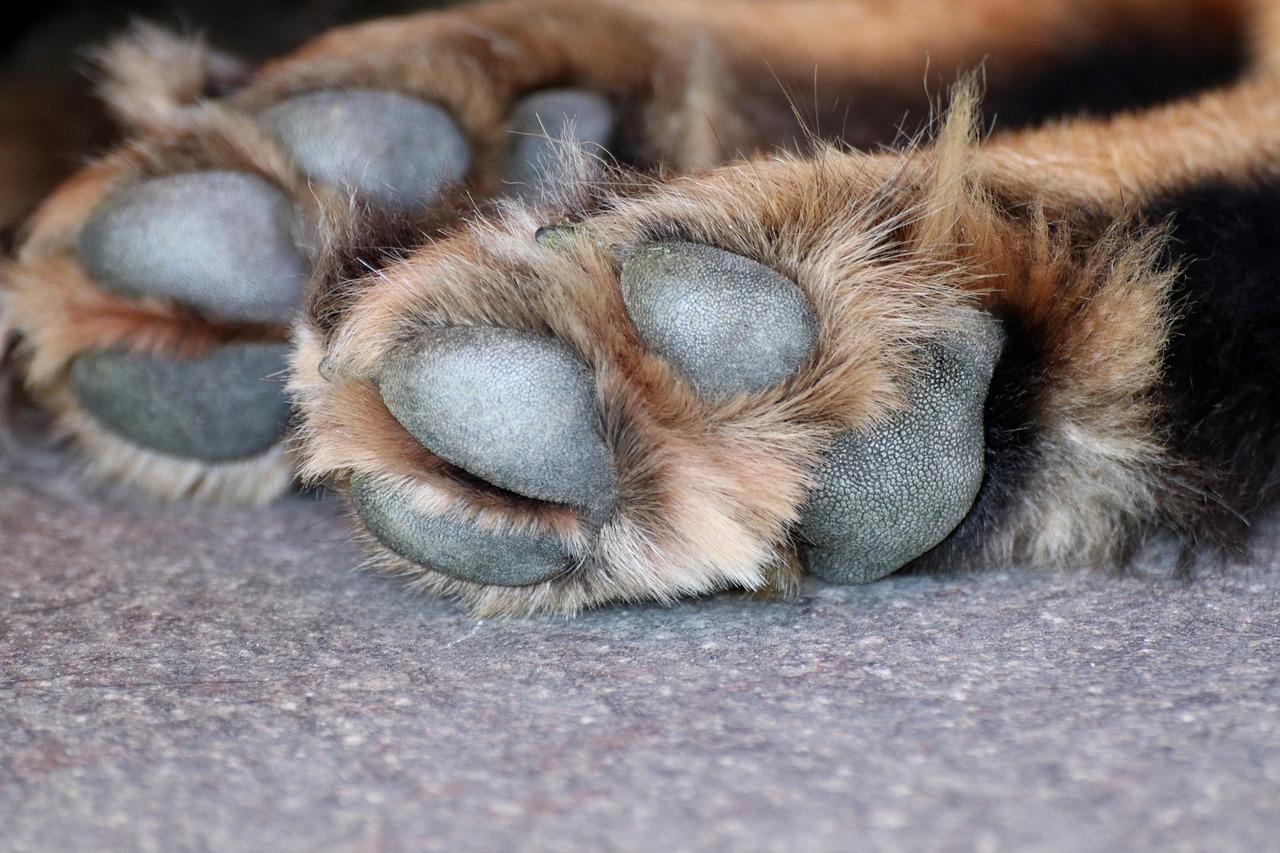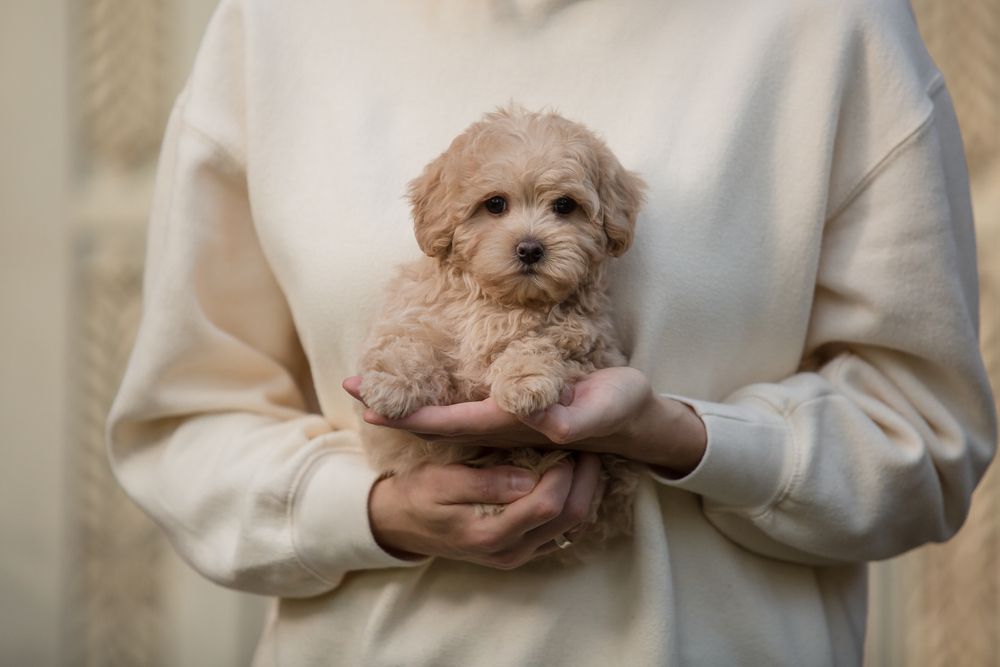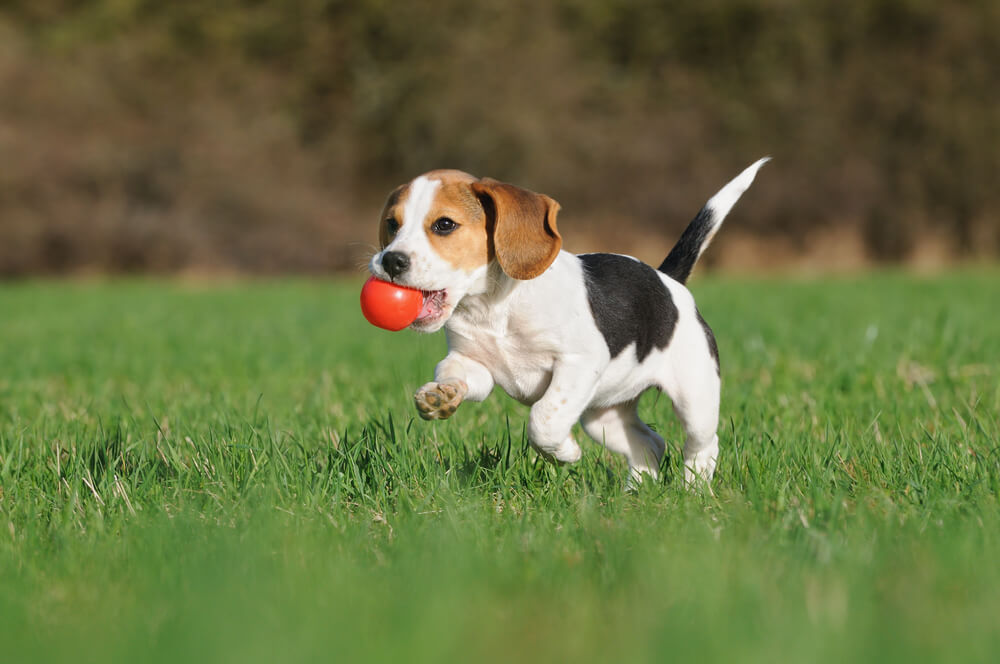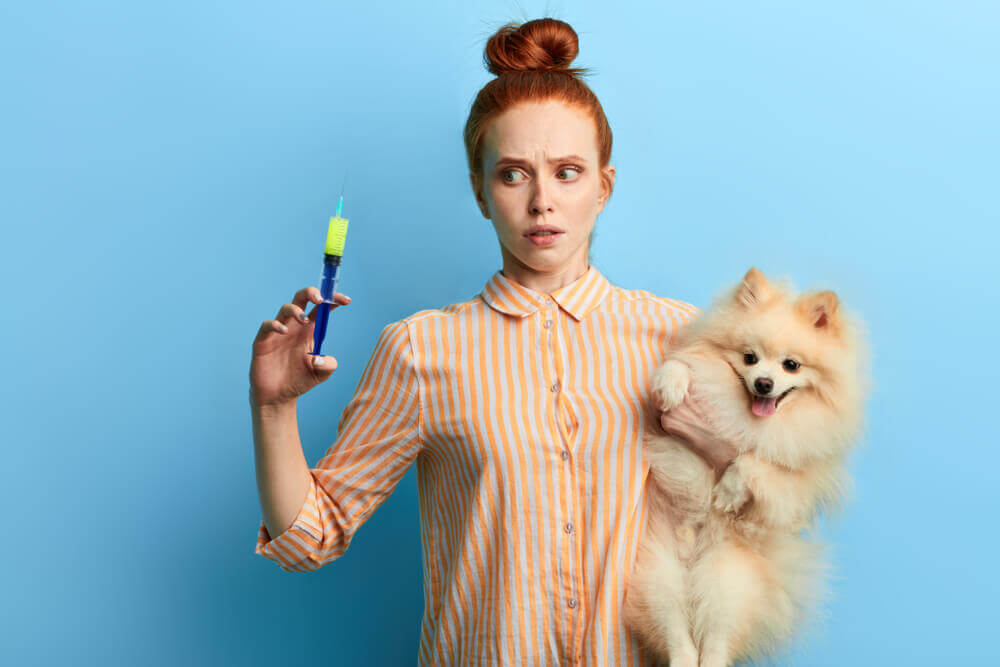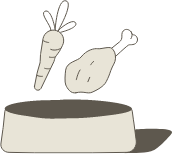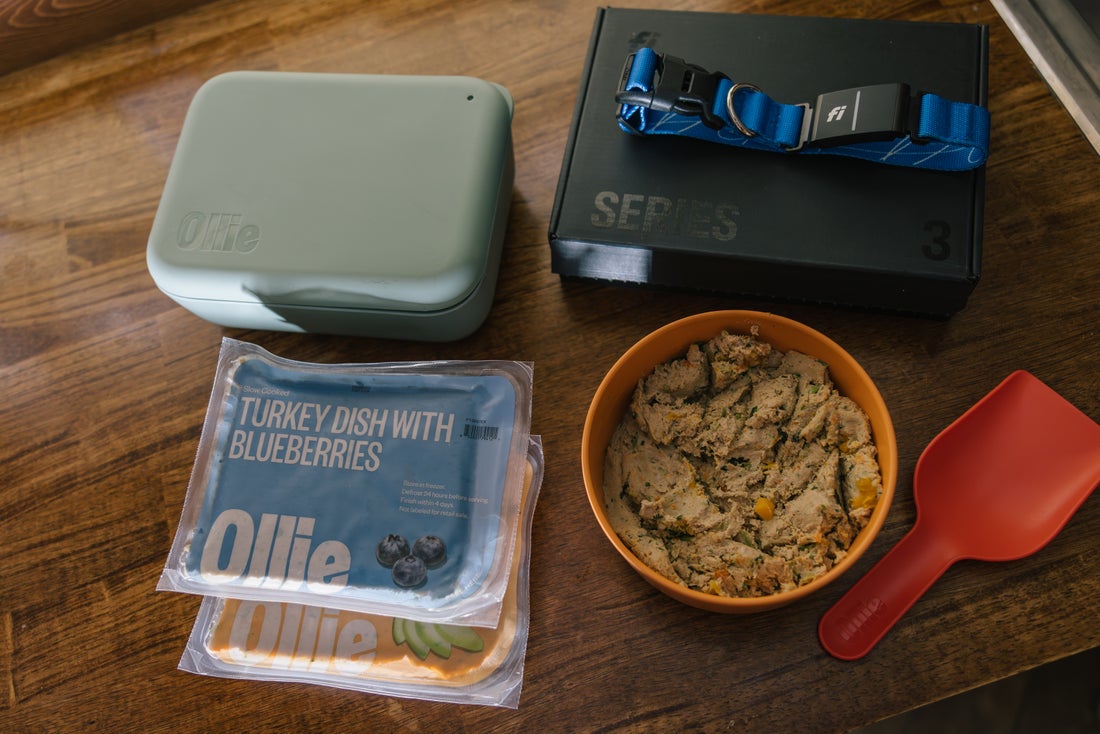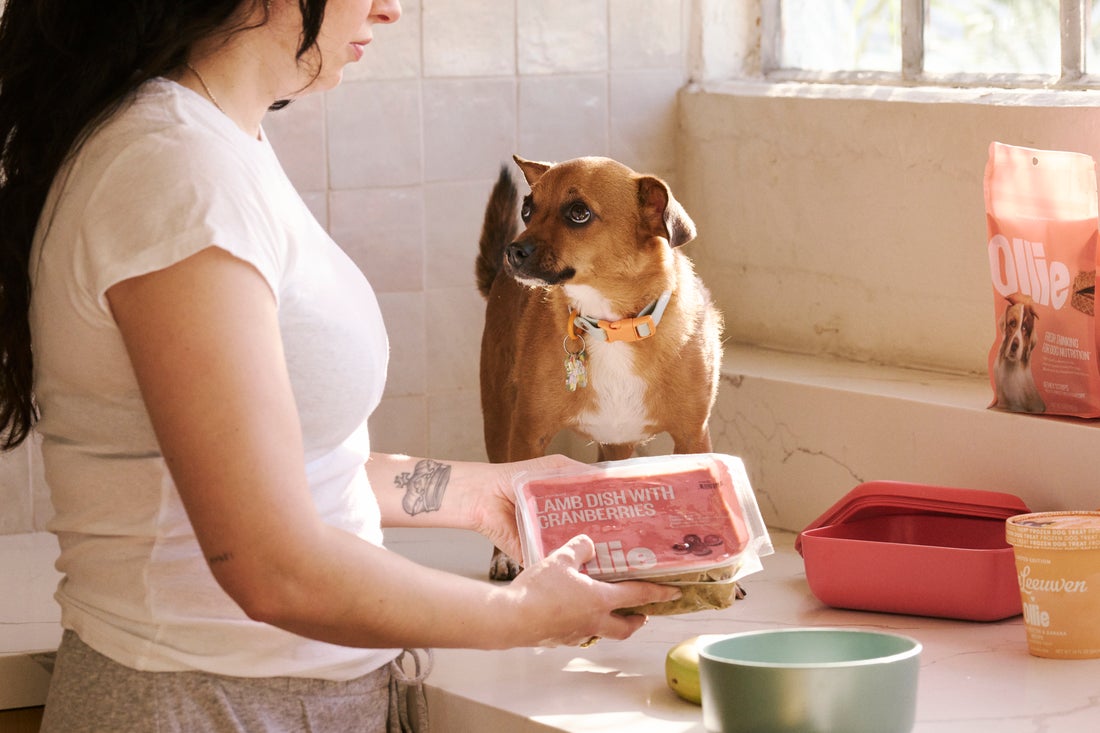Hey Ollie blog readers! We’re offering you an exclusive 60% OFF your starter box! Try now!
If you’ve ever looked over to see your dog nibbling at their feet like they’re on a mission, you’re not alone. Itchy paws are one of the top reasons dogs start licking, chewing, and — let’s be honest — driving their humans a little nuts with the nonstop sound.
Paw licking can be normal once in a while — like after a messy walk or to clean off a bit of dirt. But when it becomes constant, it usually means something deeper is bothering your dog’s paws. It might be seasonal allergies, an itchy rash between the toes, or a sign that their diet isn’t working for them.
The good news? Many paw problems are manageable once you know what’s behind the itch. There are easy things you can do at home to help calm itchy dog feet, from gentle soaks to wiping off allergens after walks. And for many dogs, switching to fresh, real food — like Ollie human grade dog food — helps tackle paw allergies from the inside out.
In this guide, we’ll break down what causes itchy paws, what you can do at home, and when it’s time to get your vet involved.
Signs Your Dog’s Paws Are Itchy
A quick lick here or there is normal, but when your dog’s licking turns into a daily habit, it’s time to look closer. Paw discomfort can sneak up slowly or show up overnight, depending on what’s causing the irritation.
Here are some signs your dog’s paws need extra attention:
Constant Licking or Chewing
If you notice your dog licking their feet every night on the couch or stopping during walks to chew their toes, it’s a clue something’s off.
Redness or Swelling
Take a peek between your dog’s toes or under their paw pads. Red skin, swelling, or raw spots are signs of irritation that can come from allergies, contact with something harsh, or even a mild infection.
Brown Staining
Dogs with paw allergies or yeast issues often develop brownish stains on their fur from constant licking. If your dog’s paws look rusty or reddish where they lick, it could be yeast or saliva staining.
Bad Odor
A funky smell coming from your dog’s paws may mean yeast or bacteria is taking hold. Healthy paws shouldn’t have a strong odor.
Limping or Avoiding Walks
If licking and chewing don’t fix the itch, your dog might start limping or favoring one foot. This usually means it’s time to act before it gets worse.
Inflammed paws can come from so many small things, from the grass your dog walks on to what’s in their bowl. That’s why the next step is understanding the real reasons behind all that licking and chewing.
Common Causes of Dog Itchy Paws
So what’s behind all the licking and chewing? There’s no single reason, but most itchy paws trace back to just a few common culprits.
1. Allergies (The Biggest One)
Allergies are the top reason dogs end up with irritated, itchy paws. There are two big types:
- Environmental Allergies: Pollen, grass, mold, or dust mites can all make your dog’s feet itchy, especially after walks or playtime outside.
- Food Allergies: Some dogs react to certain proteins or fillers in their food. These reactions often show up as red, irritated paws, ear infections, or constant licking.
2. Yeast or Bacterial Infections
Warm, damp paws are the perfect spot for yeast or bacteria to grow. If your dog’s paws smell musty or look brownish between the toes, yeast could be the problem.
3. Contact Irritants
Think road salt in winter, lawn chemicals in summer, or harsh household cleaners. If your dog walks through something irritating, it can stick to their paws and cause redness and licking.
4. Dry or Cracked Paw Pads
Hot pavement, cold weather, or dry indoor air can dry out your dog’s paw pads. Cracks or rough spots can make your dog lick for relief.
5. Behavioral Causes- Boredom or Stress
Sometimes licking paws has nothing to do with allergies at all. Some dogs lick their feet as a way to soothe themselves when they’re bored, anxious, or left alone for too long.Sometimes licking becomes a habit, even after the original irritation clears up — especially if it helped them feel better at first.
No matter the cause, healthy paws often start with what’s on your dog’s feet, and what’s in their bowl. For dogs with food-related itchy paws, switching to real, gently cooked meals like Ollie fresh recipes can help reduce flare-ups over time.
Best Home Remedies for Itchy Dog Paws
Mild paw itching doesn’t always need a prescription. For many dogs, simple at-home steps can calm irritation and stop the constant licking before it turns into a bigger issue.
Here are a few safe home remedies for dog itchy paws that can really help.
- Wipe Paws After Walks
A quick wipe with a damp cloth or pet-safe wipe removes pollen, dirt, and lawn chemicals that can stick to paws and cause flare-ups. Make it a habit when your dog comes inside, especially in allergy season.
- Soak Paws in Epsom Salt or Green Tea
A gentle paw soak can help calm irritation and fight mild yeast. Try this:
- Fill a shallow basin with warm (not hot) water.
- Add a spoonful of Epsom salt or steep a few green tea bags.
- Soak your dog’s paws for a few minutes, then pat dry.
- Use a Natural Paw Balm
Dry, cracked paw pads can make your dog lick more. Rubbing a small amount of plain coconut oil or a vet-approved paw butter can help moisturize and protect paws naturally.
- Keep Fur and Nails Trimmed
Long fur between the toes can trap moisture and debris. Keeping nails short and trimming fur between the pads helps keep paws cleaner and easier to check for irritation.
- Support Healthy Skin from the Inside
Adding Omega-3s or switching to a balanced, gently cooked diet can help calm allergies that show up in your dog’s paws. Many pet parents see fewer flare-ups when they ditch filler-heavy kibble and feed real food like Ollie fresh dog food, which supports healthy skin from the inside out.
A few small changes can bring big relief if your dog’s paw licking is mild. If things don’t improve, or the licking gets worse, the next step is figuring out what else could be behind it.
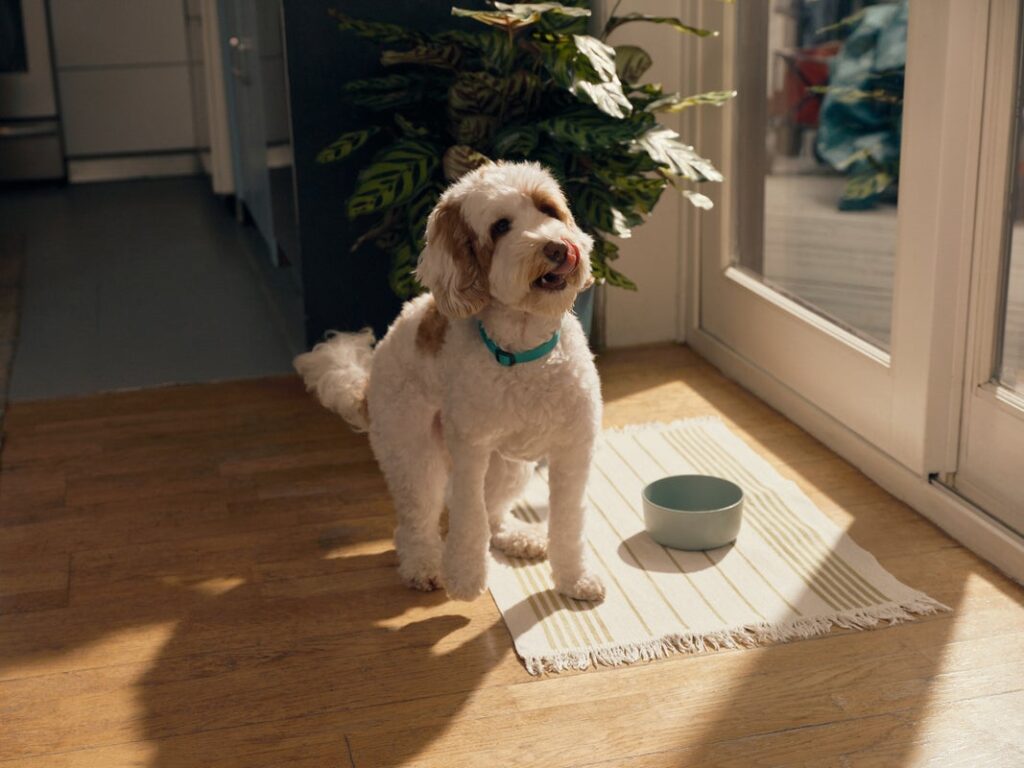
Ready to help your dog feel better — from nose to paws? Try Ollie fresh food today.
Diet and Paw Allergies: The Hidden Link
If your dog’s licking their paws nonstop and you’ve ruled out grass or road salt, food might be the hidden culprit. Many dogs with itchy feet actually have mild food sensitivities, and it shows up first between their toes.
Some proteins, grains, or fillers in cheaper dog foods can trigger a reaction in certain dogs. The result? Red, irritated paws, constant licking, repeat ear infections, and inflamed skin.
Common Food Triggers
Chicken, beef, dairy, wheat, and soy are some of the top problem ingredients for dogs with skin allergies. They’re also found in lots of basic kibble formulas. If food seems likely but it’s hard to pinpoint, your vet may suggest an elimination diet or allergy testing.
Why Fresh, Limited Ingredients Help
Switching to a fresh, limited-ingredient diet can help rule out food triggers. Real, gently cooked food skips the hidden fillers that can cause itchy paws to flare up.
Many pet parents see a big change when they ditch dry, processed kibble for simple recipes like Ollie fresh meals. Our recipes use clean proteins, real veggies, and healthy fats that support strong skin and a healthy coat, which means fewer paw problems over time.
If you suspect food might be behind your dog’s irritated paws, talk with your vet about trying an elimination diet. With the right plan (and the right bowl), you can help calm the itch where it starts. If food sensitivities are involved, it can take a few weeks to see full improvement — consistency is key.
When to See a Vet
Most mild paw licking can be handled at home with good cleaning, paw soaks, and a few simple changes. But sometimes itchy paws are a sign of something that needs more than wipes and baths.
Here’s when you should call your vet:
Signs It’s More Than a Simple Itch
- Your dog’s paws are red, swollen, or bleeding.
- There’s a strong smell (yeast or bacteria) that doesn’t clear up with cleaning.
- Your dog is licking so much they’re losing fur or making sores.
- They’re limping or avoiding putting weight on a paw.
- Home remedies help for a day or two but the itching always comes back.
What Your Vet Might Do
Your vet may run tests to check for dog paw allergies, yeast infections, or bacteria. They might recommend a prescription anti-itch med, a medicated paw rinse, or a change in diet if food sensitivities are likely.
Getting help sooner than later can keep mild paw problems from turning into painful infections, and help you figure out if your dog’s food or routine needs an upgrade too.
Long-Term Paw Care Tips
Stopping the itch once is great, keeping it from coming back is even better. The good news is, a few simple habits can help protect your dog’s paws every day.
Wipe Paws After Walks
A quick wipe removes pollen, dirt, and chemicals that can stick to paws and cause flare-ups, especially for dogs with seasonal allergies.
Keep Nails and Fur Trimmed
Long fur between the toes traps moisture and debris. Short nails and neat fur mean fewer places for irritants to hide.
Use Gentle Baths When Needed
If your dog plays in the mud or has a paw flare-up, an occasional rinse with a mild, dog-safe shampoo can help. Just don’t over-bathe, it can dry out the skin.
Stay on Top of Flea & Tick Prevention
Parasites can trigger itching all over, including your dog’s paws. Year-round flea and tick prevention cuts down on scratching and chewing.
Feed a Diet That Supports Healthy Skin
Itchy paws often start with what’s in the bowl. A diet full of clean protein, healthy fats, and real nutrients — like Ollie human grade dog food — can help keep your dog’s skin strong and less likely to flare up with allergies.
When you stick to these small daily habits, you’ll help your dog’s paws stay healthy — and the licking and chewing will stay under control.
FAQs About Dog Itchy Paws
Why does my dog keep licking his paws?
Dogs lick their paws to soothe an itch or irritation they can’t scratch. Common reasons include allergies (to food or pollen), yeast or bacteria, stuck debris, or even boredom. If the licking won’t stop, check between the toes for redness or swelling, and try a gentle wipe or soak.
What’s the best home remedy for itchy dog paws?
Start simple: wipe paws after walks, soak them in warm Epsom salt or green tea, and use a natural paw balm for dry spots. For dogs with mild food sensitivities, switching to a fresh, balanced diet like Ollie recipes can help calm flare-ups from the inside.
Why are my dog’s paws red between the toes?
Redness between the toes usually means irritation or inflammation. This could be from allergies, yeast, bacteria, or something stuck in the fur. If redness sticks around or smells bad, it’s time to check with your vet.
Can diet help stop my dog’s itchy paws?
Absolutely. Many dogs with itchy feet have hidden food sensitivities. A fresh, gently cooked meal plan without unnecessary fillers can help rule out triggers and support healthier skin. Many pet parents see paw licking ease up once they switch to real food.
When should I worry about my dog’s irritated paws?
Call your vet if your dog’s paws are swollen, bleeding, smelly, or if they’re licking so much they’re hurting themselves. If home remedies don’t help after a few days, it’s worth getting a professional check to rule out infections or bigger issues.
If itchy paws are making your dog miserable (and your nights a little noisy), don’t worry — you’re not stuck. A few simple changes — like wiping after walks, trimming fur, and switching to fresh, real food — can make a big difference.
Ollie’s gently cooked recipes skip the fillers and mystery ingredients, helping support healthier skin from the inside out. That means less licking, fewer flare-ups, and a more comfortable pup.
Ready to help your dog feel better — from nose to paws? Try Ollie fresh food today.
Tagged As:
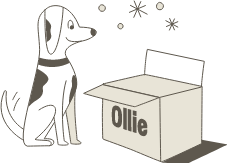
The nutrition your dog needs,
the food they want.

Enjoying our articles? Subscribe our Newsletters and get new articles directly to your inbox
You might also like
18 September 2025
5 MINS READ
Can I Rotate Fresh Dog Food Flavors?
Yes, it’s safe to rotate fresh dog food flavors, and many dogs actually benefit from the variety. At Ollie, we offer multiple fresh recipes, like Beef, Chicken, Turkey, Lamb, and Pork so you can…
by Ollie Pets
18 September 2025
5 MINS READ
Is Fresh Dog Food Safe During Power Outages?
Fresh dog food is only safe during a power outage if it has stayed cold, specifically, below 40°F. Once the temperature rises above that point, bacteria can start to grow, and the food may no lon…
by Ollie Pets
18 September 2025
5 MINS READ
How Do I Store Fresh Dog Food While Traveling?
If you’re bringing fresh dog food on the road, keeping it cold is key. The best way to store it is in a cooler with ice packs or a travel freezer. At Ollie, our vacuum-sealed fresh food stays good…
by Ollie Pets
